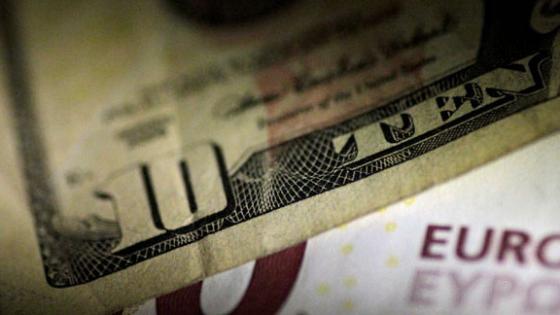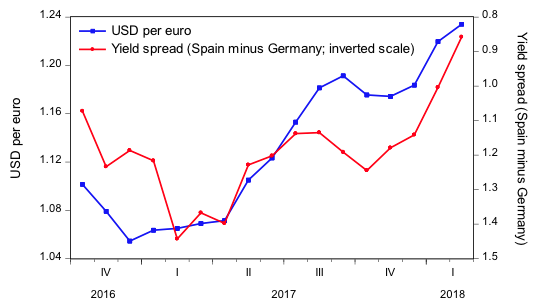The depreciation of the US dollar against the euro since early 2017 has led to much puzzlement among market commentators, central banks, and financial institutions. Following the election of President Trump, it was generally expected that the new administration’s economic policies – which would include infrastructure investment, tax reform (and reduction), and deregulation – would lead to an appreciation of the US dollar. Yet the opposite has happened. That is a source of concern, given the central role of the US dollar in the international economy (Boz et al. 2018).
What might explain the unexpected behaviour of the dollar–euro exchange rate? In this column I argue that these movements are almost entirely explained by changes in two interest rate spreads. This in-sample analysis is interesting in light of the conclusion of Cheung et al. (2017) that the dollar–euro exchange rate is particularly difficult to forecast out-of-sample.1
It is natural to start by looking at the exchange rate and the spread between interest rates in the US and in the euro area.
Figure 1 US dollar–euro rate and German–US 10-year spread
Figure 1 shows that following the election of President Trump in November 2017, the dollar appreciated from $1.10 per euro in October to $1.08 in November, and further to $1.05 in December. The election also led US interest rates to move up sharply as market participants expected President Trump’s economic policies to raise growth and inflation. As a consequence, the spread between German and US 10-year yields fell from -1.76% in October to -1.95% in November to -2.24%. Thus, the election of President Trump led to higher interest rates in the US and a stronger dollar.
From January to September, the process worked in reverse as the interest rate differential in favour of the US contracted to 1.85% and the dollar depreciated to $1.19 per euro. Two factors may have played a role. First, it became clear during the spring that President Trump would not deliver on his economic programme as quickly as initially expected, if at all. Second, economic growth in the euro area strengthened and political sentiment towards the euro improved following parliamentary elections in the Netherlands in March, the French presidential elections in late April and early May, and the French parliamentary election in June, all of which saw euro sceptic politicians lose.
But from October onward, the correlation between the exchange rate and the German-US interest rate spread collapsed.
Of course, the yields on government bonds issued by financially weaker governments in the euro area periphery may also matter for the exchange rate. For instance, concerns about the public debt or political stability may lead long yields in these countries to rise and simultaneously depreciate the euro.
To explore that, Figure 2 shows the spread between bond yields in Germany and Spain, as a measure of yield developments in the euro area periphery (note the inverted scale). The figure also shows some correlation between the two variables. In particular, the strengthening of the euro at end of sample occurred in a period in the spread of Spanish over German yields fell from 130 basis points to about 85 basis points. One would expect that to have appreciated the euro.
Figure 2 US dollar–euro rate and Spanish–German 10-year spread
To proceed, we compute the monthly changes of the two interest rate spreads and the monthly percentage change in the exchange rate. Interestingly, the correlation between the change in the German-US spread and the change in the exchange rate is 0.79 and highly significant. The correlation between the change in the Spanish-German spread and the change in the exchange rate is -0.53 and also highly significant.
With two potential explanatory variables, we next regress the change in the exchange rate on the change in German-US spread and on the change in the Spanish-German spread. The two interest rate spreads explain 78% of the variation of the exchange rate. Moreover, they have plausible effects and are statistically highly significant. Thus, a 10 basis point increase in German yields relative to US yields appreciates the euro by 1.1% (t = 8.5) in defiance of uncovered interest parity. Similarly, a 10 basis point reduction of Spanish yields relative to German yields appreciates the euro by 0.6% (t = 4.1).
Figure 3 shows the changes in the exchange rate and the parts due to changes in the German-US yield spread and the Spanish-German spread.[2] The changes in the German-US spread appear to have been the dominant driver of the exchange rate from late 2016 to October 2017. Changes in the Spanish-German yield spread also appear important, in particular in early 2018.
Figure 3 Monthly changes in the US dollar–euro rate and the parts due to changes in the German–US and Spanish–German 10-year spreads
The above analysis suggests that the depreciation of the US dollar in 2017 was due largely to long German bond yields rising relative to US yields, and to long yields in Spain (as a measure of yields in the euro are periphery) falling relative to long German yields. Since there are only 17 data points in the sample, the results may not be given much weight.
For the above analysis to be of interest, it must be that the proposed model is useful for analysis the dollar–euro rate outside of this specific sample. Re-estimating it using data since the establishment of the euro, it becomes clear that a lagged dependent variable is needed.[3] Furthermore, with 228 observations rather than 16, the explanatory power drops to 22%. However, the estimated parameters on the change of the German–US spread and the Spanish–German spread remain highly significant and, importantly, a test for a structural break at an unknown point in time does not indicate any parameter instability.
The main message from this analysis is that a large part of the fluctuations of the US dollar against the euro since the election of President Trump can be tied to movements in relative attractiveness of holding US dollars versus the euro.
References
Boz, E, G Gopinath and M Plagborg-Moller (2018) “Global Trade and the dollar,” VoxEU.org, February 11.
Cheung, Y-W, M Chinn, A Garcia Pascual and Y Zhang (2017), “Exchange rate prediction redux,” VoxEU.org, February 11.
Marcellino, M and A Abbate (2017), “Reducing the uncertainty around exchange rate forecasts: A new model,” VoxEU.org, February 4.
Rossi, B (2013), “Are exchange rates predictable?” VoxEU.org, November 14.
Endnotes
[1] See Rossi (2013) and Marcelliono and Abbate (2017) for discussion of difficulties forecasting exchange rates out-of-sample.
[2] The constant in the regression (0.92) has been subtracted from the change in the exchange rate.
[3] The parameter is 0.27 (t = 5.25).






